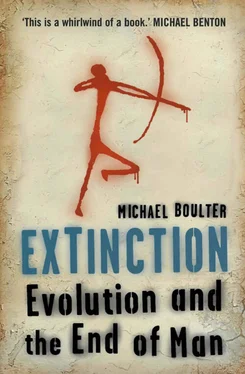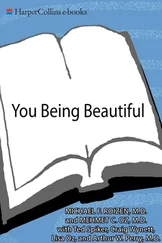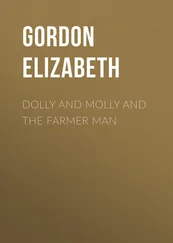Evolution and the End of Man

Cover Page
Title Page Extinction Evolution and the End of Man
Introduction
1 The Past Is Not Over
2 Extinction
3 A System out of Chaos
4 From Dinosaurs to Us
5 What’s in a Name?
6 A Man-Made Extinction Event
7 Humans and the Future
Notes
Index
Acknowledgements
About the Author
Copyright
About the Publisher
An e-mail message showed up on the screen when I logged on after breakfast. For my taste, boiled fish and rice with chopsticks don’t make the best start to the day, but the message more than made up for that. It was manna from heaven, like scrambled egg and smoked salmon, a taste of something good in this unfamiliar country.
The message was from one of my students in London, Dilshat Hewzulla. He’s a computer scientist from north-west China, a whiz kid at taking a complex system from one domain and computing it into something recognisable in another. I give him huge databases from extinct and living plants and animals, as well as from the environment, and he finds mathematically significant patterns for evolutionary and environmental interpretations. It may sound simple but it isn’t. In his e-mail Dilshat explained that in my absence we had received a letter from The Royal Society publications office saying that our manuscript had been accepted by the editor. Apparently two of the referees had waxed lyrical about it and the other had said it was rubbish and shouldn’t see the light of day. But our arguments had won through. My research group had finally gained the recognition of others and was seen to be on to something that would interest the rest of the scientific community.
With an excited feeling of satisfaction, I went off for a cup of tea. That, at least, they do have in Taiwan. I was in the capital, Taipei, at the Academy of Sciences, as the UK delegate to the General Assembly of the International Union of Biological Sciences. The tearoom was not crowded. Across the room my friend from the United States waved me to join his little group of three. They were talking about the major topic of the meeting: the effect of man changing the environment.
The day before, the Assembly had charged two of the scientists seated around that table with the task of finding ways of monitoring these changes upon the world around us. There had been hints from some delegates that without a clear programme of measurements their governments wouldn’t take the United Nations Biodiversity Convention seriously. ‘How can a forum like this agree on what to measure?’ asked one. ‘The diversity of life and environment is so big and complex, it’s hard to know where to start, and most species are not even described.’ ‘How can we bring marine and terrestrial ecologists together, whose different domains influence one another very strongly?’ ‘Do meteorologists ever speak to biologists or those modelling sea-level changes?’ Not only are there these scientific problems but also the political ones, as well as financial issues. ‘The developing world will never cooperate as long as the West carries on using so much fossil fuel,’ said the Indian delegate, ‘and even you developed nations can’t raise the money to educate people about biodiversity, let alone monitor the changes in environments.’
Later, the Assembly did agree on some priority locations. They designated areas around the world where individual animals and plants are to be identified and counted, the rainfall and temperature logged and the soil types classified. But there are so many other variables to monitoring these possible changes, and they are all affected in different ways at different rates. The scale of time to be monitored was another factor to include in the survey: changes overnight; throughout the year; a decade; a millennium; a few million years. Though my two friends are leading specialists in mainstream biology and ecology, on their own they didn’t have a clue how to begin to advise their Ministries. Theirs was an intractable dilemma. We know so little about the losses of species and ecosystems over the last hundred years, yet we all have a strong gut feeling that we are wrecking life on our planet. For governments, neither the questions nor the answers will win many votes.
But they are questions we must not shirk just because of their intractable complexity. They are not for experts in any one discipline, such as my friends in the tearoom, but for the person who can connect all the many disciplines involved. My attempt to contribute some kind of answer to this dilemma is the narrative of this book, and Dilshat’s e-mail message signalled the first attempt at a new approach. Our Royal Society paper brought together data from biology, ecology and geology and analysed them mathematically. The data come from changes that have been taking place through tens, hundreds, thousands and millions of years, and the patterns of biological diversity that emerge through evolutionary changes help understand many of the problems raised in the Taipei tearoom. The patterns our study revealed are journeys through time. The journey includes extinctions, origins and diversifications of species and larger groups. The biology matches changes that can be seen in environments, drawing the two different subjects closer together. These connections not only have an exquisite beauty when enshrined on Keats’s Grecian urn but also they are seen to have changed through the scales of geological time: ‘“Beauty is truth, truth beauty”/ – that is all ye know on earth, and all ye need to know.’
This is the story of evolution on our planet from the time of one set of extinctions to another, which covers the last 65 million years and reaches into the future. As well as clues from fossils the plot has evidence from every witness we can find – modern plants and animals, rocks, chemicals, atoms and other sources. The information and ideas come from most of the natural and physical sciences and beyond. We bring together as many of these natural processes of environment and biology as we can, as well as evidence from many hitherto separate disciplines.
I used to call myself a paleontologist because I studied fossils. My research thesis work in the 1960s looked into thousands of broken-up bits of trees that turned out to be 6 million years old. They came from a clay pit in the middle of England, a collapsed cave in the limestone hills of Derbyshire, and they showed that a warm redwood forest had once grown there. It was not unlike parts of California today but with an English scale to the landscape. So much has changed in such a geologically short period of time, yet the Peak District really did look like Sequoia National Park in California, the dense mixed forest of deciduous English oak and elm mixed with trees now native only in North America, as well as others found mainly in the East, making rich soils and colourful hills. Where there was bad soil and good drainage, heathland was much like that today; where there was wetland different but familiar plants and animals prospered.
This was a few million years before the glaciers of the ice ages penetrated into the presently highly populated temperate regions of the Earth where most of the large cities of the developed world are now situated. Before the glaciers spread from the poles, warm temperate forests dominated humid hilly landscapes. Shrubs and heath covered the drier soils and grass became widespread for the first time, encouraged by vast increases in the numbers of stooping grazing mammals. The atmosphere had more CO 2than now, which meant it was much warmer. The polar icecaps were much smaller than now, but growing. If you had taken an aeroplane journey with the usual flight paths from Europe to California, or over Siberia to Beijing, you would have seen the same kinds of forest on both trips: redwoods and warm temperate forest on the hills, swamp cypresses and shrubs near the water, like the kind you see now in the Florida Everglades. They were mixed in with more of the kinds of trees and shrubs you see in the southern United States and warm temperate China – oaks, maples, pines. Further north, a flight from Heathrow to Vancouver would cross the cooler landscape of familiar birch forest with pine and alder: there was much less sea than now, and no ice.
Читать дальше












